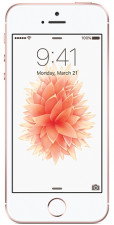
Global smartphone shipment is estimated to drop, with Apple's iPhone taking the hardest hit.
TrendForce reports the worldwide smartphone shipments in the first quarter of 2016 totalled 292 million units, down 18.6% from the previous quarter and a year-on-year decline of 1.3%. This is as a result of market saturation, it adds.
Apple posted its largest quarterly decline ever for iPhone shipments, plummeting 43.8% from 75 million units in last year's fourth quarter to just 42 million units in this first quarter, says TrendForce.
Sales of iPhone 6s have been lacklustre as the model lacks exciting new features, it adds.
Moreover, Apple's management of channel inventories have become more conservative before the launch of its next iPhone.
As a result, TrendForce has lowered its iPhone shipment estimate for this year to 213 million units, an almost 10% drop compared with the previous year.
Furthermore, Apple is unlikely to make a turnaround for this year's shipments with the iPhone SE, says the Analyst firm.
TrendForce smartphone analyst Avril Wu says as the budget model, iPhone SE will support Apple's overall shipments in the second quarter before the next major iPhone release.
However, iPhone SE is going to face severe price competition from Chinese branded products in its target market, which is the mid-range device segment.
This year's iPhone SE shipments are projected to come in below 15 million units and they are unlikely to help turn around the weak annual shipment result for Apple, she adds.
World Wide Worx MD Arthur Goldstuck says it is hard to see where the iPhone SE will fit in the market, adding the mid-level small screen smartphone market is already well fleshed out.
According to IDC market estimate, mature markets like US, China, and Western Europe all hit single digit growth in 2015, while high growth markets such as India, Indonesia, the Middle East and Africa, and other pockets in Southeast Asia, all remained healthy.
The mature market slowdown has some grave consequences for Apple, as well as the high-end Android space, as these were the markets that absorbed the majority of the premium handsets that shipped over the past five years, says Ryan Reith, programme director with IDC's Worldwide Quarterly Mobile Phone Tracker.
Leading brands such as Samsung and Apple no longer have the same growth momentum as before, says TrendForce. Therefore, the overall shipments depended on contributions from Chinese brands and rising demand in India and other emerging markets, it notes.
The smartphone market is saturated, therefore smartphone companies have to give consumers new ideas, new technology or better pricing to persuade them to upgrade, says Goldstuck. Apple is in short supply in all these areas as far as the iPhone is concerned, he adds.
In SA, Samsung is by far the dominant smartphone brand, says Goldstuck.
"It is only when we look at high-end flagship phones do we see Apple compete at a similar level to Samsung.
"The leadership in that top segment tends to change based on whether a new flagship device has just been launched. Right now, Samsung is in the ascendancy in the high end segment."
Samsung's first-quarter shipments exceeded expectations and arrived at 81 million units, up 2.5% from the prior quarter. It boosted its smartphone sales by launching its flagships Galaxy S7 and S7 Edge ahead of schedule and stepping up its promotional activities.
Wu points out the combined shipments (including exports) from Chinese brands in the first quarter reached 125 million units, surpassing the combined shipments from Samsung and Apple for the first time.
Chinese brands accounted for 42.9% of the global smartphone shipments, up from 41.5% in the previous quarter.
Huawei's first-quarter shipments came in at 27 million units, or a drop of around 20% compared with the prior quarter. Nonetheless, the Chinese smartphone maker retained its rankings as the top brand in China and the third-largest vendor worldwide. Huawei currently is ahead of its domestic competitors in terms of scale, technology, and supply chain integration.
"Huawei won't be able to overtake Apple and become the No 2 smartphone brand worldwide any time soon," said Wu. "Still, the market share gap between Huawei and Apple are expected to narrow with each passing year."
Lenovo smartphone shipments reached 17 million units in the first quarter, translating to a small quarterly decline of 5.6%. Also, Xiaomi shipped about 16 million units of smartphones in the first quarter and is now in close competition with Lenovo for the No 2 spot in China. Meanwhile OPPO and Vivo together will represent almost 20% of Chinese branded smartphone shipments for 2016, says TrendForce.
Share